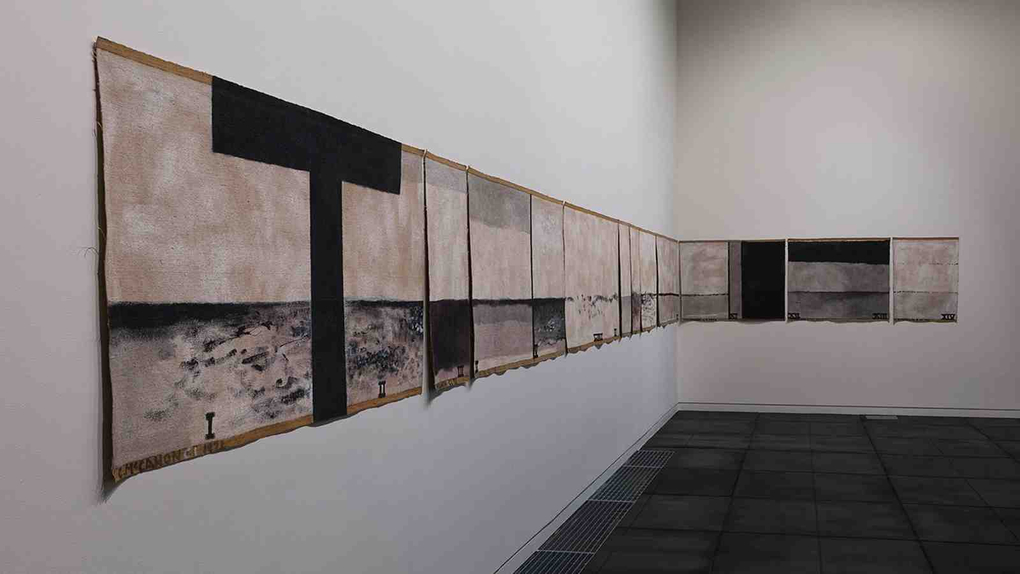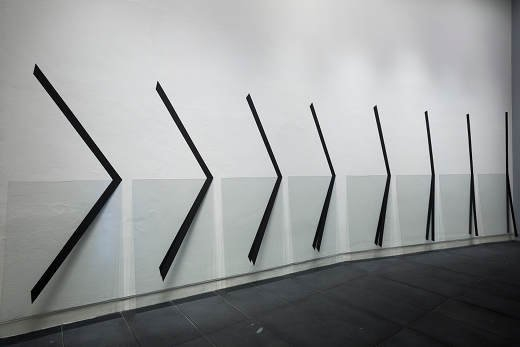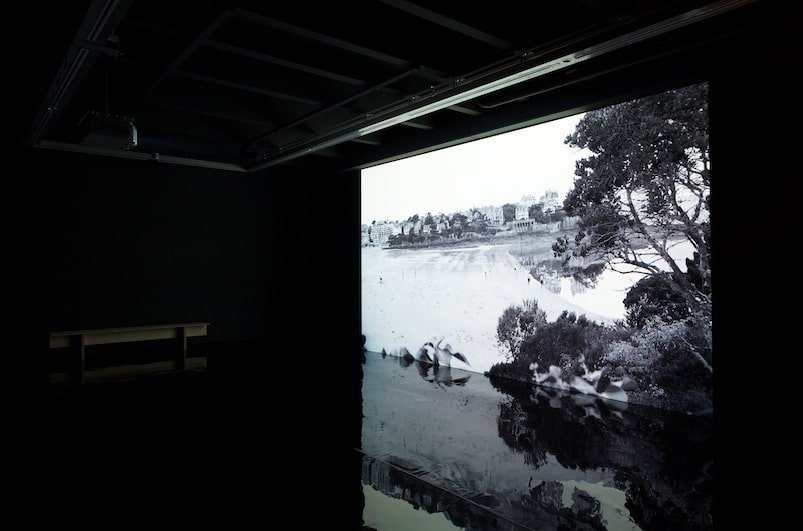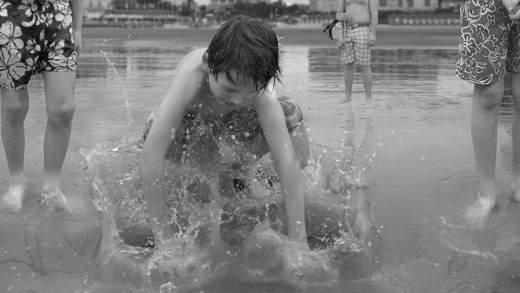I stream TIMEX, a sound work by Hummel, on my iPhone, listening closely to it in the cocoon of my headphones. It is twelve minutes long, the length of my train ride to work. I sit on the train. I listen to it on my commute, Pōneke harbour skimming past outside the window. Long and short. I listen to it on the way home. I walk along Lambton Quay. I am in the Happy Sun Dairy. I am on the number seven bus.
TIMEX is a reflection of the world I move through. The work is structured by a static pulse which flickers every four bars at a tempo of 120 bpm. The description of the work tells me that this is the "average heartbeat rate of a brisk walking pace." When I am walking, I time my heartbeat against it. This metronomic pulse is interpolated by flickers of sampled sounds: "birdcalls; the distant ocean; rain on the tin roof of a bach; the internal workings of a digital camera as it seeks to find focus; a burst of AM radio static; fumbling to unlock a door with my hands full; a snatch of Christchurch City demolition; a bumble bee bumping against a pane of glass, and a mechanical drill to finish." These are known, prosaic sounds—sounds that I can hear if I stop and take off my headphones. TIMEX’s layered simulacrum of everyday life highlights its contradictory nature: the combination of staccato fragments with monotonous repetition; the long and the short; the semiquaver and the semibreve.
TIMEX was created as a response to the exhibition The Specious Present at the Adam Art Gallery, which combines work by Andrew Beck, David Claerbout, Colin McCahon, and Keith Tyson, and the sound work provides an interesting frame through which to approach the show—a show itself which is replete with "approaches" of different kinds. The curatorial frame of the show is the limits of our perception of the present, and how artists understand and then represent the passage of time through different media: painting, photography, video, installation, and, in the case of Hummel, sound.
I walk around the city with TIMEX filtering through my headphones, similar to the way that McCahon envisioned the viewers of Walk (Series C) (1973) to walk along and past the painting, encouraging a physical, as well as a visual understanding of the work. Though painted, and therefore static, Walk (Series C) guides the viewer to receive information incrementally; the meaning is deferred and under construction until you arrive at the end. Though, as in the static metronome of TIMEX, the line of the horizon acts as an anchor, the metaphor through which McCahon’s metaphysical questioning reveals itself.

Installation view of Walk (Series C) (1973) Colin McCahon. Synthetic polymer paint on unstretched jute canvas, 11 panels, 933 x 12200mm. Collection of Museum of New Zealand Te Papa Tongarewa
The long, corridor-like galleries of the Adam Art Gallery are well suited to the approach and encounter of McCahon’s paintings. I coast by Walk (Series C) and, along the linear Upper Chartwell gallery, I walk towards The Days and Nights in the Wilderness Showing the Constant Flow of Light Passing into a Dark Landscape (1971), installed tantalisingly on the end wall of this space. In this work, the still medium of painting is activated by the text written across it—the semiotic shuffling and interplay of text and image that characterises much of McCahon’s work. The title is full of gerunds: "showing" and "passing"; this work is painted in the present tense. Again, the flicker and flow of the days and nights are grounded by the monumental T in the centre of painting; the Tau cross. Time ebbs and flows, but it is structured, centered, as in the horizon line of Walk (Series C), as in the logos, the God, the definition of the beginning and the end.
McCahon’s works are installed in direct conversation with Andrew Beck’s silver gelatin prints and sculptures, exhibited in the galleries below. The juxtaposition illustrates the productive tension and dynamic of the show which is inter-generational, and includes a heterogeneous selection of media (though this heterogeneity does not extend to gender or race, as the artists included are exclusively white men). Similar to McCahon’s, Beck’s works encourage passage and movement; Linear Split (8 phases) (2015) literally points the viewer across the work—an imperative to cross and re-cross.

Installation view of Linear Split (8 phases) (2015) Andrew Beck. Acrylic on eight sheets of non-reflective glass with wall painting, Eight glass sheets 1350 x 900mm. Courtesy of the artist and Hamish McKay Gallery, Wellington
Beck’s training is in photography, but his art elides the boundaries of this discipline, and overlaps and expands into sculptural installation. The Specious Present is Beck’s first show in a public gallery (his work is particularly well-suited to the muted black, white, and grey palette of the Adam’s architecture; several of the works could have almost independently emerged from the black floor), and Beck makes use of the space he was given to develop these works. Beck is interested in the materiality of photographic techniques and processes and, in many cases, renders these visible through the abstract forms of his work. Frames are doubled and dragged; the arc of the sun is captured; lines are inverted and paired, and outlines are blurred. The works develop a syntax of the passage of time, the movement of the sun, and the demanding strictures of the Adam’s architecture.
The Specious Present also turns to the screen and moving image, media which operates in a different temporal mode. In Beck’s and McCahon’s works, you decide where and when you enter the work, your eyes roam over the plane of the paintings and photographs, you can stand for as long or as short as you like. Moving image works, however, have a beginning and an end, you enter half way through or at the very end, and the work will unfold from your serendipitous point of entry.
British artist Keith Tyson’s video work, Art-Machine Iteration: Angelmaker Part 1: 15 Seconds Prior to Apocalypse, 100 Views (1996–8) provides a postmodern, less theologically structured (in direct comparison to McCahon) meditation on the passage of time. The video is displayed on a small, squat monitor—its modest display underscored by its location between the two looming McCahons—and shows a series of mundane images: trees blowing in the wind, people sitting on benches, traffic, milling crowds of people. As announced by the title, the video purports to depict the "seconds prior to the apocalypse" and thus highlights the impossibility of understanding or predicting the future. Humankind, as shown in this work, is suspended continually in the present, going about its day-to-day activities, and the future is displaced, unknowable.
 UK_520.jpg)
Still from Art-Machine Iteration: Angelmaker Park 1, 15 Seconds Prior to Apocalypse, 100 Views (1996-1998) Keith Tyson. Video, 25 min looped. Zabludowicz Collection, London
Angelmaker Part 1 feels like the visual corollary of TIMEX; I can almost hear the static, breathless heartbeat of TIMEX when watching the humdrum scenes roll past. Both artists find constraint productive when considering the nature of time: in the case of TIMEX, it is the predetermined pace of the 120 bpm measure, and in the case of Keith Tyson, the directives of his so-called “Artmachine”, a system that he created for determining the outcome and visual manifestation of his artworks. These circumscribed structures allow both artists to examine seemingly random moments, arrange images and sound in a linear chronology to depict the mosaic of the present in all its multiplicity.
David Clarebout’s work The Quiet Shore (2011), exhibited downstairs, in the dark of the Kirk gallery, is an extraordinary installation, and I want to finish with it because the work exists somewhere between the media of the other art in the show—photography, film, sculpture, installation, painting—and is a provocative synthesis of these disciplines.
The Quiet Shore shows one moment on a beach in Northern France; the location of the work further underscores its "in between-ness", as the beach is the site of a strong tide which creates a mesmerising, glassy, reflective space in between sea and shore. The work slowly traces the different perspectives of the people on the beach and the seaside buildings, technology somehow, inexplicably, employed to show one single second from multiple views. The work incrementally unfolds to reveal the contradiction of its title. Though the scene is mundane, we are shown a complex drama of characters and setting, each person shown, literally, in the round, so we are invited to create a narrative and characterization. This shore is not ‘quiet’, but alert and alive with drama and suspense; all eyes on the beach are drawn down towards a child splashing at the water’s edge.
The Quiet Shore follows the linear chronology of the cinema screen and the repetition of the filmstrip, but through its ingenious depiction of a single moment, it also hovers on the edge of sculpture. As the viewers, we are able to ‘walk around’ the image and examine it from different angles. Similar to McCahon’s, Beck’s, and Hummel’s work, we can walk around the depicted moment, whether that is along the work in the gallery space, with headphones on in the real world, or optically, circling the scene, as The Quiet Shore allows us to do. In this way, The Specious Present can perhaps be understood as a series of walks and approaches; the present moment activated and understood through movement.

Installation view of The Quiet Shore (2011) David Claerbout at the Adam Art Gallery (2015). Courtesy of the artist; Micheline Szwajcer, Brussels; Sean Kelly, New York; and Untilthen, Paris
The Specious Present is a thoughtful and incisively constructed exhibition. Though, one absence that occurred to me as I walked through several days with TIMEX on my headphones, was a depiction of time in the everything-all-at-once simultaneity of media and information which characterises our contemporary moment. All the works in The Specious Present are subtle, each work carefully edited and measured out—individually and collectively they have a quiet approach. The show could have benefitted from an oppositional rapid-fire energy and aesthetic, perhaps by another video artist, to throw the other works into relief. Regardless though, The Specious Present, rewards multiple and close viewing. Time spent here is time gained.
